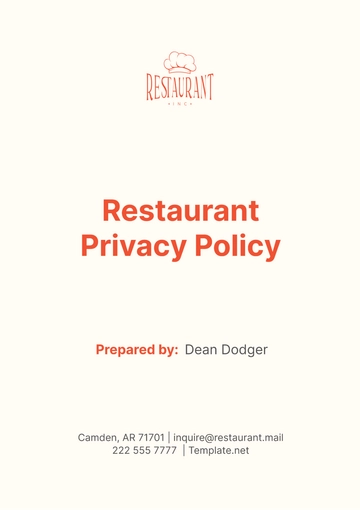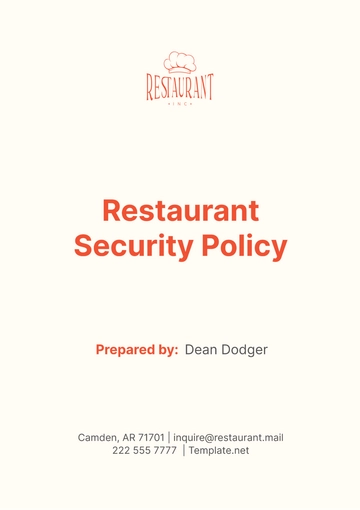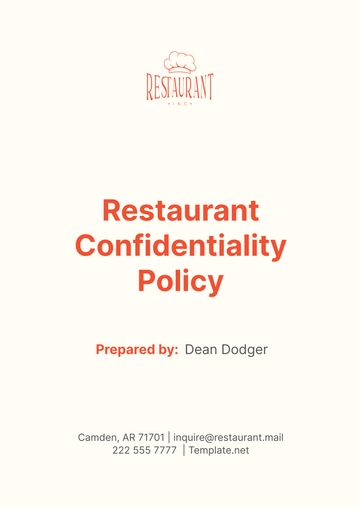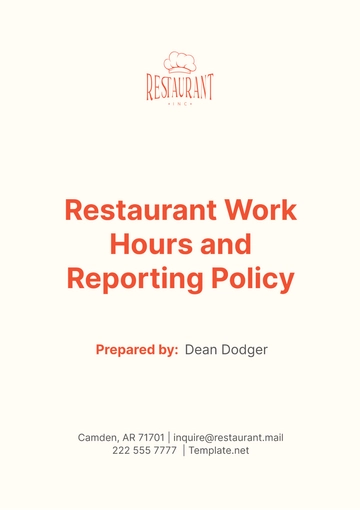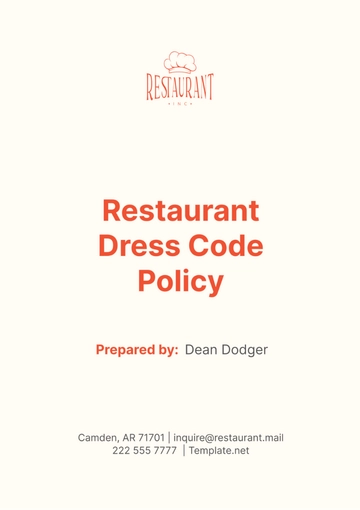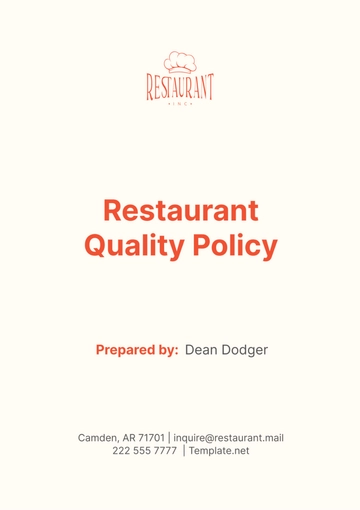Free Restaurant Procedure Policy

I. Introduction
A. Purpose of the Policy
The purpose of this Restaurant Procedure Policy is to establish clear guidelines and procedures for all staff members to follow in order to maintain high standards of service, safety, and efficiency in our restaurant operations. By adhering to these procedures, we aim to ensure consistency in the quality of food and service provided to our customers, promote a hygienic and safe working environment for our staff, and uphold compliance with relevant regulations and industry standards.
B. Scope of the Policy
This policy applies to all employees and contractors working within our restaurant premises, including front-of-house staff, kitchen staff, management personnel, and support staff. It encompasses all aspects of restaurant operations, including food handling and preparation, customer service, staff conduct, hygiene and sanitation practices, reservation and seating procedures, billing and payment processes, and emergency procedures.
C. Compliance with Regulations
All procedures outlined in this policy are designed to ensure compliance with local health codes, food safety regulations, and industry best practices. By adhering to these regulations and standards, we not only protect the health and safety of our customers and staff but also safeguard the reputation and success of our restaurant in the community.
II. Food Handling and Safety Procedures
A. Food Preparation Guidelines
Proper food preparation is essential to ensuring the quality and safety of our menu items. All staff members are required to wash their hands thoroughly before handling food, use separate cutting boards and utensils for raw and cooked foods to prevent cross-contamination, follow recipes and portion control guidelines to maintain consistency, and label and date all prepared food items for proper rotation and storage.
B. Food Storage and Rotation
Effective storage and rotation practices help minimize waste and prevent foodborne illnesses. Perishable items should be stored at appropriate temperatures to prevent spoilage, and stock should be rotated on a first-in, first-out (FIFO) basis to ensure freshness. It's important to keep storage areas clean and organized to prevent cross-contamination and maintain food quality.
C. Hygiene and Sanitation Practices
Maintaining high standards of hygiene and sanitation is crucial in a restaurant setting. All staff members are required to clean and sanitize all surfaces, equipment, and utensils regularly to prevent the spread of bacteria and pathogens. Additionally, wearing gloves and hairnets when handling food, and properly disposing of garbage and waste are essential practices to ensure food safety and cleanliness.
D. Allergen Awareness and Handling
Allergen awareness is paramount to ensuring the safety of our customers with food allergies or dietary restrictions. Menu items containing common allergens must be clearly labeled, and staff should be educated about allergen awareness and cross-contact prevention. Special dietary requests should be accommodated with care and attention to avoid any accidental exposure to allergens.
E. Temperature Control Measures
Proper temperature control is critical to preventing foodborne illness. Staff should monitor and record temperatures of refrigerators, freezers, and hot-holding equipment regularly to ensure they are operating within safe ranges. Additionally, food items should be cooked to recommended internal temperatures to kill harmful bacteria, and leftover food should be quickly chilled and reheated to minimize the risk of contamination.
F. Cleaning and Disinfection Protocols
Maintaining a clean and sanitary environment is essential for food safety and customer satisfaction. Develop a comprehensive cleaning schedule for different areas of the restaurant, ensuring that all surfaces, equipment, and utensils are cleaned and sanitized regularly. Proper training should be provided to staff on cleaning techniques and safety precautions to ensure effective disinfection and prevent the spread of illness.
III. Customer Service Standards
A. Greeting and Seating Procedures
The first impression sets the tone for the entire dining experience. Staff members should greet customers warmly and promptly upon arrival, acknowledging their presence and making them feel welcome. After greeting customers, staff should promptly escort them to their tables, provide menus, and ensure that the seating area is clean and well-prepared for their arrival. Throughout the dining experience, maintaining a clean and welcoming atmosphere in the dining area is essential to enhancing the overall customer experience.
B. Order Taking and Accuracy
Accurate order-taking is crucial to ensuring customer satisfaction and minimizing errors in the kitchen. Staff should listen attentively to customers' orders, repeating them back to ensure accuracy, and confirming any special requests or modifications. Clear communication between front-of-house and kitchen staff is essential to ensure that orders are prepared correctly and delivered promptly to the table.
C. Timeliness of Service
Timely service is a key factor in customer satisfaction. Staff should strive to serve food and beverages promptly after they are prepared, minimizing wait times and ensuring that customers receive their orders in a timely manner. Regularly checking on tables throughout the meal allows staff to address any issues or concerns promptly, ensuring that customers feel attended to and valued during their dining experience.
D. Handling Customer Complaints
Handling customer complaints with professionalism and empathy is essential to resolving issues and maintaining customer satisfaction. Staff should listen attentively to customer concerns, apologize sincerely for any inconvenience, and take prompt action to address the issue. Offering appropriate solutions or compensation, such as replacing a dish or providing a discount on the bill, can help to resolve the situation and leave the customer feeling valued and appreciated.
E. Upselling and Cross-Selling Guidelines
Effective upselling and cross-selling can enhance the dining experience for customers and increase revenue for the restaurant. Staff should be knowledgeable about menu items and able to offer recommendations and suggestions to customers based on their preferences. However, it's important to avoid being pushy or aggressive in upselling efforts, as this can detract from the customer experience and lead to dissatisfaction. Instead, staff should focus on providing helpful and relevant suggestions that enhance the overall dining experience for the customer.
IV. Staff Conduct and Appearance
A. Dress Code Policy
Maintaining a professional appearance contributes to the overall atmosphere of the restaurant and reflects positively on our brand. All staff members are required to adhere to the dress code policy, which typically includes wearing clean and appropriate attire, including uniforms or aprons provided by the restaurant. Personal grooming standards should also be maintained, including neat and tidy hair, minimal jewelry, and no visible tattoos or piercings that could detract from the professional image of the restaurant.
B. Personal Hygiene Standards
Staff members are expected to maintain high standards of personal hygiene to ensure the safety and well-being of our customers and fellow employees. This includes regular handwashing, proper grooming, and refraining from smoking or chewing gum while on duty. Staff members who handle food are required to wear gloves and hairnets to prevent contamination.
C. Professional Behavior Expectations
Professionalism is paramount in all interactions with customers, colleagues, and management. Staff members should conduct themselves in a courteous, respectful, and helpful manner at all times, treating customers with kindness and empathy. Any disputes or conflicts should be handled discreetly and professionally, with a focus on finding a resolution that satisfies all parties involved.
D. Handling Cash and Tips
Staff members entrusted with handling cash and tips are expected to do so with honesty, integrity, and accuracy. Cash handling procedures should be followed meticulously to minimize the risk of errors or discrepancies. Tips should be distributed fairly and transparently among staff members according to established policies, ensuring that all employees are compensated fairly for their contributions.
V. Reservation and Seating Procedures
A. Reservation Policy
Reservations are an important aspect of managing the flow of customers and ensuring a positive dining experience. Staff should be familiar with the reservation policy, including how to accept, confirm, and manage reservations effectively. It's important to communicate clearly with customers about reservation availability, wait times, and any special requirements or preferences they may have.
B. Seating Assignments and Rotation
Efficient seating assignments and rotation help to maximize seating capacity and ensure a smooth flow of customers throughout the restaurant. Staff should be proactive in seating and reassigning tables as needed to accommodate incoming guests and balance workload among servers. Fair and equitable rotation of sections helps to distribute workload evenly and ensure that all servers have an opportunity to serve a variety of guests.
C. Handling Special Requests and Accommodations
Customers may have special requests or requirements, such as dietary restrictions, seating preferences, or special occasions. Staff should be attentive and accommodating to these requests, striving to fulfill them to the best of their ability while maintaining the overall operation of the restaurant. Clear communication between front-of-house and kitchen staff is essential to ensure that special requests are executed accurately and efficiently.
VI. Billing and Payment Processes
A. Payment Options Accepted
Providing customers with convenient payment options enhances the overall dining experience and helps to streamline the billing process. Staff should be familiar with the payment options accepted by the restaurant, including cash, credit cards, and mobile payment methods. Clear signage should be displayed to inform customers of accepted payment methods and any additional fees or surcharges that may apply.
B. Handling Checks and Credit Cards
Accuracy in handling checks and credit card transactions is essential to prevent errors and discrepancies. Staff should double-check the accuracy of checks before presenting them to customers and verify the authenticity of credit cards before processing payments. Secure procedures should be followed to protect customer information and prevent fraud or theft.
C. Splitting Checks Policy
Splitting checks can be a complex and time-consuming process, especially for large groups. Staff should be familiar with the restaurant's policy on splitting checks and communicate it clearly to customers. Whenever possible, staff should offer alternatives such as separate checks or electronic payment options to simplify the process and minimize errors.
D. Gratuity Guidelines
Gratuities are an important source of income for many restaurant staff members and should be handled with care and transparency. Staff should be familiar with the restaurant's policy on gratuities, including any automatic gratuity charges for large parties or special events. Tips should be distributed fairly among staff members according to established guidelines, with clear communication about the distribution process to ensure transparency and accountability.
VII. Emergency Procedures
A. Fire Safety Protocols
Fire safety is a top priority to ensure the well-being of customers and staff. All employees should be trained in fire safety protocols, including how to evacuate the building safely in the event of a fire, how to operate fire extinguishers, and how to respond to fire alarms. Regular fire drills should be conducted to ensure that staff are prepared to respond quickly and effectively in case of an emergency.
B. Medical Emergencies Response
Quick and appropriate response to medical emergencies can save lives. Staff should be trained in basic first aid and CPR techniques and know how to summon emergency medical assistance if needed. Designated staff members should be responsible for contacting emergency services and guiding paramedics to the location of the emergency.
C. Evacuation Procedures
In the event of an emergency requiring evacuation, staff should follow established evacuation procedures to ensure the safety of customers and themselves. This includes calmly guiding customers to designated exit routes, assisting those with mobility challenges, and assembling at designated meeting points outside the building. Regular training and drills help to familiarize staff with evacuation procedures and ensure a swift and orderly evacuation in case of emergency.
D. Security Measures
Maintaining a safe and secure environment is essential for the well-being of customers and staff. Staff should be vigilant and attentive to any signs of suspicious activity or potential security threats and report them immediately to management or authorities. Security measures such as surveillance cameras, alarm systems, and trained security personnel may be implemented to enhance safety and deter criminal activity.
VIII. Training and Development
A. New Employee Orientation
Proper training and orientation are essential for new employees to learn their roles and responsibilities and integrate into the team effectively. New employees should receive comprehensive training on restaurant policies and procedures, including food handling and safety protocols, customer service standards, and job-specific tasks. Ongoing support and guidance should be provided to help new employees adjust to their roles and become productive members of the team.
B. Ongoing Training Programs
Continuous training and development opportunities help to enhance the skills and knowledge of all staff members and improve overall performance. Regular training sessions should be conducted to reinforce key concepts, introduce new policies or procedures, and provide updates on industry trends or regulations. Staff should be encouraged to participate in training programs and seek opportunities for professional growth and development.
C. Certification Requirements
Certain roles within the restaurant may require specific certifications or qualifications to ensure competence and compliance with regulations. Staff members should be aware of any certification requirements associated with their job roles and take appropriate steps to obtain and maintain these certifications. Management should provide support and resources to help staff members meet certification requirements and stay up-to-date with training and licensing.
D. Performance Evaluation Criteria
Regular performance evaluations help to assess staff members' performance, identify areas for improvement, and recognize achievements. Clear performance evaluation criteria should be established, outlining the expectations and standards for each role within the restaurant. Feedback should be provided to staff members regularly, both formally through performance evaluations and informally through ongoing coaching and communication.
IX. Communication Protocols
A. Internal Communication Channels
Effective communication is essential for smooth operations and teamwork within the restaurant. Staff should be familiar with the various communication channels used within the restaurant, including verbal communication, written communication (such as memos or shift notes), and electronic communication (such as email or messaging apps). Clear and open communication helps to ensure that everyone is informed and on the same page regarding important updates, changes, or issues.
B. Reporting Incidents and Issues
Encouraging staff to report incidents, accidents, or issues promptly helps to address them before they escalate into larger problems. Staff should know how to report incidents to management or designated personnel, including the details to include in their reports and the appropriate follow-up procedures. A culture of transparency and accountability fosters trust and collaboration among staff and management.
C. Staff Meetings and Briefings
Regular staff meetings and briefings provide opportunities to share information, discuss updates or changes, and address any concerns or questions. Meetings should be conducted regularly and include all relevant staff members, covering topics such as upcoming events, menu changes, or operational updates. These meetings also provide a forum for staff to voice their opinions, share ideas, and contribute to the overall success of the restaurant.
D. Feedback Mechanisms
Creating channels for feedback allows staff to provide input, suggestions, or concerns to management, fostering a culture of continuous improvement. Staff should be encouraged to share feedback openly and constructively, whether through formal feedback mechanisms such as surveys or suggestion boxes, or informal channels such as one-on-one discussions with supervisors. Management should take feedback seriously and use it to inform decision-making and drive positive change within the restaurant.
X. Compliance and Monitoring
A. Regular Inspections and Audits
Regular inspections and audits help to ensure compliance with regulations, identify areas for improvement, and maintain high standards of quality and safety. Management should conduct routine inspections of the restaurant premises, equipment, and procedures to assess compliance with health codes, food safety regulations, and internal policies. Any issues or deficiencies identified should be addressed promptly and followed up with corrective actions.
B. Documentation and Record-Keeping
Accurate documentation and record-keeping are essential for demonstrating compliance with regulations and tracking performance over time. Staff should maintain detailed records of key activities, such as food safety checks, equipment maintenance, and staff training, in accordance with established procedures. Documentation should be organized, easily accessible, and kept up-to-date to facilitate inspections, audits, and reporting requirements.
C. Review and Revision Process
Policies and procedures should be reviewed regularly to ensure they remain current and effective. Management should establish a formal review process for policies and procedures, including timelines for review, criteria for evaluation, and stakeholders involved in the review process. Feedback from staff, changes in regulations or industry standards, and lessons learned from incidents or audits should all be considered in the review process.
D. Consequences of Non-Compliance
Non-compliance with restaurant policies and procedures may result in disciplinary action, up to and including termination of employment. Staff should be aware of the consequences of non-compliance and the importance of adhering to established standards and guidelines. Consistent enforcement of policies and procedures helps to maintain accountability and integrity within the organization.
- 100% Customizable, free editor
- Access 1 Million+ Templates, photo’s & graphics
- Download or share as a template
- Click and replace photos, graphics, text, backgrounds
- Resize, crop, AI write & more
- Access advanced editor
Manage your restaurant operations with ease using the Restaurant Procedure Policy Template from Template.net. This editable and customizable template, equipped with an AI Editor Tool, simplifies the creation of comprehensive policies. Ensure compliance and efficiency by tailoring procedures to your establishment's needs. Streamline staff training and uphold industry standards effortlessly with this essential resource.
You may also like
- HR Policy
- Restaurant Policy
- Company Policy
- Accounting Policies and Procedures
- Website Policy
- Privacy Policy
- Safety Policy
- School Policy
- IT and Software Policy
- Law Firm Policy
- Construction Policy
- Interior Design Policy
- Travel Agency Policy
- Education Academic Policy
- Security Policy
- Real Estate Policy
- Expense Policy
- Software Policy






